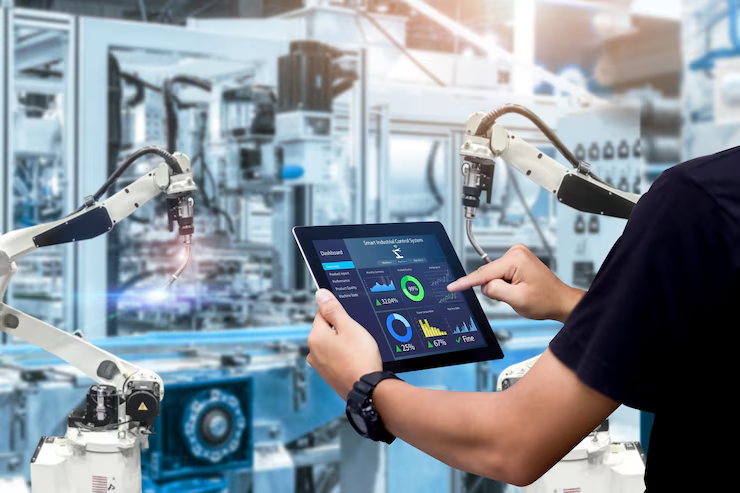Robotic Process Automation (RPA): Transforming the Future of Work
In the ever-evolving digital landscape, organizations are under increasing pressure to innovate, reduce costs, and improve efficiency. Robotic Process Automation (RPA): Transforming the Future of Work .Among the many technological solutions available today, Robotic Process Automation (RPA) has emerged as a key driver of business transformation. By automating mundane and repetitive tasks, RPA allows companies to reallocate human resources to more strategic roles, enhancing productivity and agility.

This article explores the concept of RPA, its benefits, challenges, applications, and future implications. Whether you’re a business leader, IT professional, or curious learner, this comprehensive guide will provide you with a deep understanding of RPA and its potential to revolutionize work.
What is Robotic Process Automation (RPA)?
Robotic Process Automation is a technology that uses software “robots” or “bots” to emulate human actions interacting with digital systems. These bots can perform a wide variety of rule-based tasks—such as data entry, processing transactions, generating reports, and sending emails—across multiple applications and platforms.
Unlike traditional automation, which often requires complex integrations and system overhauls, RPA works at the user interface level. This means it can interact with existing systems without altering underlying infrastructure, making it highly versatile and relatively easy to implement.
Key Features of RPA Robotic Process Automation
-
Rule-based Automation: RPA excels at performing tasks governed by clear rules and structured data.
-
Non-Invasive Integration: RPA tools operate on the surface layer, mimicking user actions without changing core systems.
-
Scalability: Bots can be deployed and scaled across various functions as needed.
-
Auditability: RPA maintains logs of each process, enabling monitoring, compliance, and auditing.
-
Speed and Accuracy: Bots execute tasks rapidly and with minimal errors, significantly improving efficiency.

How RPA Works
RPA software typically consists of three core components:
-
Bot Creator (Design Studio): Used to design and develop automation workflows. Most platforms offer a visual interface that allows users to “drag and drop” actions.
-
Bot Runner: Executes the bots on desktop or server environments.
-
Control Center: Manages, monitors, and schedules bots, and provides insights into performance and compliance.
Bots follow a predefined set of instructions to replicate tasks such as:
-
Logging into systems
-
Copying and pasting data
-
Extracting and processing data from documents
-
Sending notifications or reports
-
Handling customer service queries
Benefits of RPA
1. Operational Efficiency
RPA significantly reduces the time required to perform tasks. Bots can work 24/7, without breaks, holidays, or human error.

2. Cost Savings
Organizations can achieve up to 30–60% cost reduction through automation. Tasks that took hours can now be completed in minutes.
3. Improved Accuracy
By eliminating human intervention in repetitive tasks, RPA reduces errors and enhances data quality and compliance.
4. Scalability and Flexibility
RPA systems are easy to scale. Businesses can deploy additional bots to handle increased workloads without hiring more staff.
5. Employee Satisfaction
By relieving employees of monotonous tasks, RPA enables them to focus on creative, value-added work—boosting job satisfaction and engagement.
Common Applications of RPA Robotic Process Automation
RPA can be used in virtually every industry. Here are some notable use cases:

Banking and Finance
-
Loan processing
-
KYC verification
-
Reconciliation
-
Fraud detection
Healthcare
-
Patient scheduling
-
Claims processing
-
Data migration from legacy systems
-
Billing and coding
Retail and E-commerce
-
Order processing
-
Inventory management
-
Customer queries
-
Invoice generation

Human Resources
-
Employee onboarding
-
Payroll processing
-
Attendance tracking
-
Benefits administration
IT Services
-
Automated system monitoring
-
Incident management
-
User account provisioning
-
Software installation and updates
Popular RPA Tools in the Market Robotic Process Automation
Some leading RPA tools widely used by businesses include:

-
UiPath
-
Automation Anywhere
-
Blue Prism
-
Pega
-
Kofax
-
Microsoft Power Automate
Each tool comes with its own strengths in terms of ease of use, integration, scalability, and pricing. UiPath, for example, is praised for its user-friendly interface and active developer community.
Challenges and Limitations of RPA Robotic Process Automation
Despite its advantages, RPA comes with certain limitations:
1. Not Suitable for All Tasks
RPA is best for rule-based processes. It struggles with tasks requiring cognitive decision-making or unstructured data.
2. Maintenance Overhead Robotic Process Automation
Bots may need regular updates to accommodate changes in UI or workflows, which can increase maintenance efforts.
3. Security Risks
Improper access controls or bot misuse can pose security vulnerabilities. Ensuring secure bot behavior is essential.
4. Employee Resistance
Employees may fear job displacement due to automation. Change management and clear communication are critical for successful implementation.
RPA vs. Intelligent Automation
RPA is often the first step in an organization’s automation journey. However, as businesses evolve, they look for more intelligent solutions. This leads to the integration of RPA with Artificial Intelligence (AI) and Machine Learning (ML)—a concept known as Intelligent Automation (IA) or Hyperautomation.
Key differences:
| Feature | RPA | Intelligent Automation |
|---|---|---|
| Data | Structured | Structured & Unstructured |
| Learning Capability | No | Yes |
| Decision-making | Rule-based | AI-based |
| Examples | Invoice processing | Chatbots, document understanding |
Future of RPA Robotic Process Automation
The future of RPA is intertwined with advancements in AI, cognitive computing, and data analytics. Some key trends include:
-
Hyperautomation: Combining RPA with AI, ML, and process mining to create end-to-end automation ecosystems.
-
Cloud-based RPA: Offering more flexibility, scalability, and lower entry barriers for small and mid-sized businesses.
-
Citizen Developers: Empowering non-technical users to create bots using no-code/low-code platforms.
-
Process Discovery Tools: Using AI to identify and recommend processes that are best suited for automation.
Implementing RPA: Best Practices
-
Start Small: Begin with pilot projects that offer high ROI and low complexity.
-
Choose the Right Tools: Evaluate RPA vendors based on scalability, ease of use, and support.
-
Engage Stakeholders: Get buy-in from management, IT, and end-users.
-
Focus on Governance: Establish clear rules for bot management, security, and compliance.
-
Measure Success: Define KPIs and track improvements in efficiency, accuracy, and cost savings.
Conclusion
Robotic Process Automation is more than a technological innovation—it’s a strategic enabler of digital transformation. By automating repetitive tasks, organizations can unlock new levels of efficiency, agility, and employee satisfaction. However, the success of RPA depends on careful planning, appropriate tool selection, and continuous improvement.
As the technology continues to mature, its integration with AI and analytics will pave the way for smarter, more autonomous systems—ushering in a new era of intelligent business operations.


